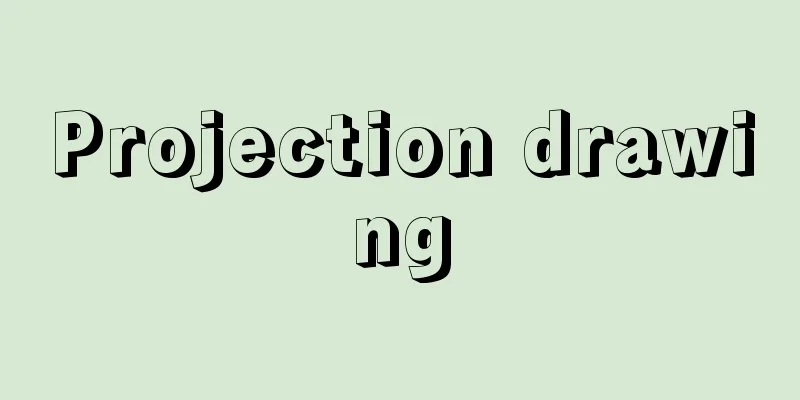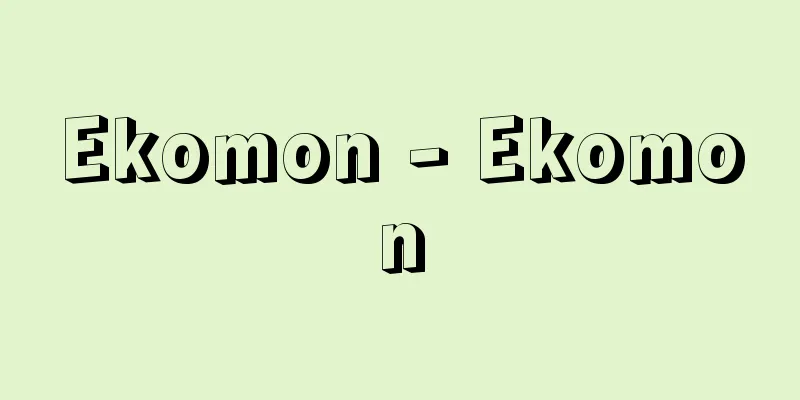Projection drawing

|
It is also called a projection drawing. Projection is the act of transferring a three-dimensional figure onto a plane based on certain rules, and a projection drawing refers to the plane figure that is transferred. The rules are to first focus on the points that make up the three-dimensional figure, introduce straight lines (projection lines) that pass through those points, and then find the intersections between those lines and the plane (projection surface), which is the projection drawing. Furthermore, different projection methods arise depending on the type of projection line. Parallel projection occurs when the projection lines are parallel to each other, and central projection occurs when all projection lines pass through a fixed point (center of projection). The former is further divided into direct projection and oblique projection, depending on whether the projection line is perpendicular to the projection surface or not. The perfection of these projection methods dates back to G. Monge's descriptive geometry, in which the task of drawing is to create a projection and at the same time solve various problems of three-dimensional figures in a precise manner using the projection. The conditions for this are that the projection must be easy to see what is being depicted, and that the quantities of the original figure (length, angle, area, etc.) can be accurately restored. Central projection is superior to the former, as can be seen from the fact that perspective projection, a pictorial method, is a type of central projection, while direct projection is easier to handle the latter, since the projection line is perpendicular to the projection surface. Oblique projection occupies a position in between. One of them is chosen depending on the purpose. In order to accurately restore the quantities of the original figures, it is necessary to have one-to-one correspondence between the points of the three-dimensional figures and the points of the projection drawings. To achieve this, there are methods such as increasing the projection surface and introducing numerical values. The former is called orthogonal projection, which introduces a projection plane (upright projection plane) perpendicular to the original projection plane (horizontal projection plane) and projects perpendicularly onto that plane. It is a compound projection. The projections are called plan and elevation, respectively. The space divided into four by the two projection planes is called the first angle (quadrant), second angle, third angle, and fourth angle, respectively. In principle, the method of placing the object in the first angle is called the first angle method, and the method of placing the object in the third angle is called the third angle method. The horizontal and upright projection planes mentioned above are also called flat screen and vertical screen in the third angle method. These projection planes are rotated around the intersection line (baseline) of the plane as the axis of rotation and overlapped. In other words, the plan and elevation are drawn on the same plane. In addition, subprojections are added, which introduce another projection plane perpendicular to the horizontal projection plane (sub-upright projection plane, sub-elevation), a projection plane perpendicular to the upright projection plane (sub-horizontal projection plane, sub-plan view), etc. One method of introducing numerical values is axonometric projection, which introduces three orthogonal coordinate axes, quantifies the points of the original figure by their distance from the coordinate plane, and projects each coordinate onto a projection plane. The original points are accurately matched by the relationship between the projection drawing and the coordinate axes and the numerical values. Depending on the angle of the projection line to the projection plane, projections are divided into orthogonal axonometric projection and oblique axonometric projection. Another method is elevation projection. This is a type of orthogonal projection, in which the projection line is measured in units of scale, quantified, and written next to the projection drawing. [Yoshio Tamakoshi] “Basic Zugaku” by Yoshio Tamakoshi and Sadahiko Nagae (1980, Kyoritsu Publishing)” [Reference] |©Shogakukan "> Projection (Parallel Projection) ©Shogakukan "> Projection (central projection) ©Shogakukan "> Projection (orthographic) ©Shogakukan "> Projection drawing (secondary projection, secondary upright projection, secondary elevation drawing… ©Shogakukan "> Projection (sub-projection, sub-horizontal projection, sub-plan… ©Shogakukan "> Projection drawing (axonometric projection) ©Shogakukan "> Projection (elevation projection) Source: Shogakukan Encyclopedia Nipponica About Encyclopedia Nipponica Information | Legend |
|
投象図ともいう。三次元図形を一定の規約に基づいて平面上に写すことを投影というが、投影図とはその写された平面図形をさす。その規約とは、まず三次元図形を構成する諸点に着目して、その諸点を通る直線(投射線)を導入して、その直線と平面(投影面)との交点を求め、これを投影図とするものである。さらに、投射線の種類によって異なる投影法が生ずる。投射線が互いに平行な場合に平行投影が、すべての投射線が一定点(投影中心)を通る場合に中心投影が生ずる。前者はさらに、投射線が投影面に垂直な場合とそうでない場合とで直投影と斜投影とに分かれる。 これら投影法の完成はG・モンジュの画法幾何学にさかのぼる。そこでは、投影図の作成と同時に、投影図において三次元図形の諸問題を精密な方法で解決することが図学の課題とされている。その条件として投影図には、何が写されているかが容易にわかることと、元の図形の量(長さ、角度、面積など)が正確に復元できることが要請される。中心投影は、絵画の画法の透視図法がその一類であることよりわかるように、前者に優れており、直投影は、投射線が投影面に垂直であることより、後者の取扱いが容易である。斜投影はその中間の位置を占める。目的に応じてそれらの一つが選ばれる。 元の図形の量の正確な復元には、三次元図形の諸点と投影図の諸点が一対一に対応することが必要である。そのために、投影面を増やす方法と、数値を導入する方法などがある。 前者は正投影といって、元の投影面(水平投影面)に垂直な投影面(直立投影面)を導入して、その面上にも直投影する方法である。複面投影である。その投影図はおのおの平面図、立面図という。二つの投影面で四分される空間をおのおの第一角(象限(しょうげん))、第二角、第三角、第四角というが、原則として対象を第一角に置く法を第一角法、第三角に置く法を第三角法という。先の水平投影面、直立投影面を第三角法では平画面、立画面ともいう。この投影面は、その面の交線(基線)を回転軸にして回転して重ねられる。つまり、平面図と立面図が同一平面上に図示される。さらに、水平投影面に垂直な別の投影面(副直立投影面、副立面図)、直立投影面に垂直な投影面(副水平投影面、副平面図)などを導入する副投影が加わる。 数値を導入する方法の一つは、三直交座標軸を導入してその座標面からの距離で元の図形の諸点を数値化し、座標ごと一投影面上に投影する軸測投影である。投影図と座標軸との関係と数値によって元の諸点に正確に対応する。その際の投射線の投影面への角度によって、直(正)軸測投影、斜軸測投影に分かれる。もう一つの方法は標高投影である。これは直投影の一類であり、投射線を単位尺で計って数値化し、投影図の側にそれを添え書きする方法である。 [玉腰芳夫] 『玉腰芳夫・長江貞彦著『基礎図学』(1980・共立出版)』 [参照項目] |©Shogakukan"> 投影図(平行投影) ©Shogakukan"> 投影図(中心投影) ©Shogakukan"> 投影図(正投影) ©Shogakukan"> 投影図(副投影〈副直立投影面、副立面図… ©Shogakukan"> 投影図(副投影〈副水平投影面、副平面図… ©Shogakukan"> 投影図(軸測投影) ©Shogakukan"> 投影図(標高投影) 出典 小学館 日本大百科全書(ニッポニカ)日本大百科全書(ニッポニカ)について 情報 | 凡例 |
>>: Selection of Toei Poetry - Toei Shisen
Recommend
Brown-marmorated stinkbug (Halyomorpha nalys)
Hemiptera, Heteroptera, Heteroptera, Hemiptera. It...
Sufi (English spelling) Abū-al-Husain 'Abd al-Rahmān ibn 'Umar al-Rāzī al-Sūfī
One of the greatest Muslim astronomers. Born near...
Bioko
…Official name: Republic of Equatorial GuineaRepú...
Foreign funds - Gaishikinko
...For this reason, the Wartime Finance Bank was ...
Goose claws
〘 noun 〙 (named after its shape resembling a wild ...
Otani Sobyo Shrine
The ancestral temple of the Otani sect of Shinshu ...
Pheasant Bank - Pheasant Bank
…Both males and females take turns incubating and...
Kamogata [town] - Kamogata
An old town in Asakuchi County, southwest of Okaya...
Vlado Perlemuter
1904‐2002 A French pianist of Polish origin. He st...
Trachyandesite
It is an alkaline volcanic rock with a chemical c...
Myoepithelial cells
Cells that surround the terminal part of an exocri...
Calanthe izu-insularis (English spelling) Calantheizuinsularis
…[Ito Gohiko]. … *Some of the terminology that me...
DEN - Electricity
A network management technology that uses director...
Outside position - Gei
A series of ranks under the Ritsuryo system. Duri...
capital city
A city where a country's governing body is lo...









